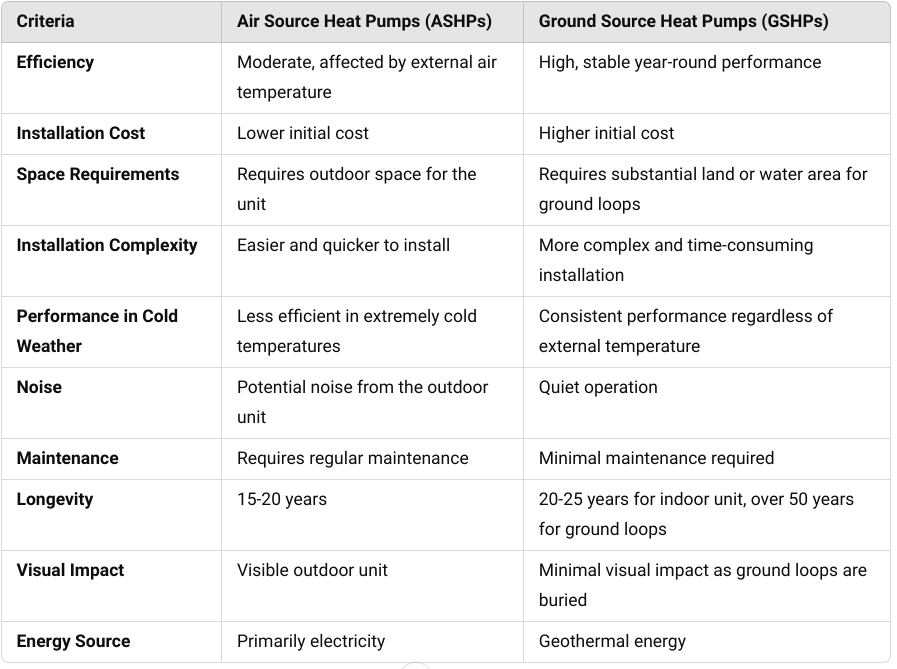Decarbonising buildings has become an important focus in the effort to reduce carbon emissions and combat climate change, and heating and cooling systems significantly contribute to energy consumption and carbon emissions in both residential and commercial buildings. Among the most effective solutions for reducing this carbon footprint are air source heat pumps (ASHPs) and ground source heat pumps (GSHPs).
In this guide, we’ll compare ASHPs and GSHPs, highlighting their benefits and exploring how they can transform homes and businesses into more energy-efficient and environmentally friendly spaces. By understanding the differences between these two types of heat pumps, you can make informed decisions about which system might be the best fit for your property, contributing to a sustainable future while enjoying the practical and financial benefits of these innovative technologies.
At Cooper Weston, we offer our professional decarbonisation services and sustainable building upgrades throughout London and the South of England. Contact our experts today for a free no-obligation quote.
What is decarbonisation?
Decarbonisation refers to the process of reducing carbon dioxide (CO₂) emissions, particularly from human activities, to mitigate climate change. This involves transitioning from fossil fuels to renewable energy sources, enhancing energy efficiency, and adopting technologies that minimise carbon output.
In the context of buildings, decarbonisation aims to lower the carbon footprint by using sustainable heating, cooling, and insulation methods, thereby contributing to a cleaner and more sustainable environment.
What is a decarbonisation strategy?
A decarbonisation strategy is a comprehensive plan designed to reduce carbon emissions. It may include measures such as:
- installing energy-efficient heating and cooling systems
- improving insulation
- utilising smart energy management systems
The goal is to achieve significant reductions in carbon emissions, which will contribute to the broader effort to limit global warming and help ensure a sustainable future.
Energy saving strategies for commercial buildings
Understanding heat pumps and their role in decarbonisation
Heat pumps work by absorbing heat from a natural source – such as air, ground, or water – and transferring it to the building’s interior, or vice versa. This process requires a minimal amount of energy, making heat pumps an environmentally friendly option compared to traditional fossil fuel-based heating systems.
When decarbonising buildings, replacing traditional heating systems with heat pumps significantly reduces carbon emissions. Traditional heating systems, like those powered by natural gas or oil, emit large amounts of CO₂, whereas heat pumps use renewable sources of energy, which have a much lower carbon footprint.
Another benefit for homes and businesses looking to reduce emissions is that heat pumps are cheaper to run in the long term as they transfer heat rather than generate it, resulting in lower energy bills. Whilst initial installation may seem expensive, they have lower operational costs, reduced maintenance costs, and longer operational lifespans.
There are two main types of heat pumps to consider: air-source heat pumps and ground-source heat pumps.
Read our case study: Green Heating Solutions For Battersea Old Windsor
What is an air source heat pump?
An air source heat pump (ASHP) is a device that extracts heat from the outside air to heat or cool a building efficiently. It works by absorbing heat from the air and transferring it indoors through a refrigerant cycle. This cycle involves compressing the refrigerant to increase its temperature, then releasing the heat into the building’s heating system, such as radiators or underfloor heating.
An air source heat pump typically resembles a large outdoor unit, similar to an air conditioner, with a fan, grille, and vents. It is usually installed on an exterior wall or on the ground next to a building. The unit needs sufficient airflow and should be placed in an open area, away from obstructions. Inside the building, a heat exchanger and associated components are connected to the indoor heating system, distributing heat or cool air throughout the space.
Benefits of an air source heat pump
- Energy efficiency: ASHPs are highly efficient, often producing three to four units of heat for every unit of electricity consumed.
- Cost savings: Reduced energy consumption translates to lower energy bills over time.
- Lower installation costs: Easier and less expensive to install compared to ground source heat pumps (GSHPs).
- Versatility: Suitable for a variety of building types and climates.
- Environmental impact: Reduces carbon footprint by using renewable energy sources.
- Heating and cooling: Provides both heating in winter and cooling in summer, offering year-round comfort.
- Low maintenance: Fewer moving parts lead to lower maintenance requirements and costs.
- Renewable energy integration: Can be powered by renewable energy sources like solar or wind power.
- Government incentives: Eligibility for various government incentives and rebates aimed at promoting energy-efficient technologies.
- Longevity: Long lifespan of 15 to 20 years with proper maintenance.
Challenges of an air source heat pump
- Reduced performance in extremely cold temperatures: In very cold weather, air source heat pumps may struggle to extract sufficient heat from the air, leading to decreased efficiency and increased reliance on backup heating systems.
- Potential noise issues: The outdoor unit of an air source heat pump can generate noise, which might be a concern in residential areas or for those sensitive to sound.
- Energy consumption for defrosting: In cold climates, energy is needed to defrost the outdoor unit, slightly reducing overall efficiency.
- Visual impact: The outdoor unit can be unappealing and may not complement the building’s aesthetics.
- Space requirements: The installation requires adequate outdoor space, which may be challenging for properties with limited exterior space.
- Maintenance: Requires regular maintenance to ensure optimal performance and longevity.
What is a ground source heat pump?
A ground source heat pump (GSHP) is a system that extracts heat from the ground to heat or cool a building. It works by circulating a refrigerant through underground pipes (ground loops), which absorb heat from the earth. The heat is then compressed to a higher temperature and transferred to the building’s heating system.
A ground source heat pump system includes an indoor unit that looks similar to a furnace or boiler and an outdoor network of underground pipes (ground loops). The indoor unit is installed inside the building, often in a utility room or basement. The ground loops are buried horizontally in trenches or vertically in boreholes or placed in a pond or lake near the building, requiring sufficient land or water space for installation.
Benefits of a ground source heat pump
- High efficiency: GSHPs are highly efficient, often producing more heat energy than the electrical energy they consume.
- Consistent performance: Provides reliable heating and cooling year-round, regardless of outside temperatures.
- Longevity: Ground loops can last over 50 years, and the indoor components typically last 20-25 years with proper maintenance.
- Low operating costs: Lower energy bills due to high efficiency and reduced reliance on fossil fuels.
- Environmental impact: Reduces carbon footprint by using renewable geothermal energy.
- Quiet operation: Indoor units operate quietly, with no external compressor noise.
- Heating and cooling: Can provide both heating in winter and cooling in summer, offering comprehensive climate control.
- Increased property value: Enhances the value of the property due to its energy efficiency and sustainability.
- Low maintenance: Requires minimal maintenance compared to traditional heating systems.
- Eligibility for incentives: May qualify for government incentives and rebates promoting renewable energy use.
Challenges of a ground source heat pump
- High upfront costs: Installation costs are significantly higher than those of traditional heating systems and even air source heat pumps.
- Land requirements: Sufficient land is required for horizontal ground loops or space for vertical drilling, which may not be feasible for all properties.
- Installation complexity: A more complex installation process involving extensive groundwork, which can be disruptive and time-consuming.
- Permits and regulations: Specific permits and compliance with local regulations may be required, adding to the complexity and cost.
- Site suitability: Not all sites are suitable for ground source heat pumps, particularly in densely populated urban areas or where ground conditions are not favourable.
- Potential for ground disturbance: Installation can disturb the landscape, requiring restoration work post-installation.
Air source heat pumps vs ground source heat pumps
Choosing between these two heat pumps depends on various factors and suitability for your building. This table will compare ASHPs and GSHPs to highlight their differences side-by-side and help you understand which system might be the best fit.

To make an informed decision about which heat pump system will best meet your heating and cooling needs, consult with experienced decarbonisation and sustainable building upgrades professionals like Cooper Weston.
Gas boiler ban 2035
In the UK, when considering more environmentally friendly energy sources, it’s essential to know about the government’s ban on the installation of new gas boilers in homes starting in 2035. This is part of a broader strategy to achieve net-zero carbon emissions by 2050.
While the ban currently focuses on residential properties, similar regulations may likely eventually apply to commercial buildings as part of net zero goals. Switching to heat pumps now can help commercial properties stay ahead of regulatory changes and avoid future compliance issues. This is in addition to the benefits of energy cost savings and a reduced carbon footprint.
The UK government offers various incentives and financial support to encourage the adoption of renewable heating technologies, including heat pumps. Commercial properties can benefit from grants, subsidies, and other financial mechanisms designed to offset the initial investment costs of heat pump systems.
Choose Cooper Weston for your building’s decarbonisation
Choosing the right partner for your building’s decarbonisation and transition to heat pumps is crucial. At Cooper Weston, we stand out as leaders in the field, offering trusted expertise and comprehensive services, and our team of experienced professionals will provide tailored solutions to meet your building’s specific needs.
Our services include consultation, installation, maintenance, and ongoing support to help achieve optimal performance and a more sustainable future. As we’re committed to quality, innovation, and customer satisfaction, heat pump installation with us is seamless and effective.
Get in touch today for a free no-obligation quote from our highly-skilled, reliable team.







